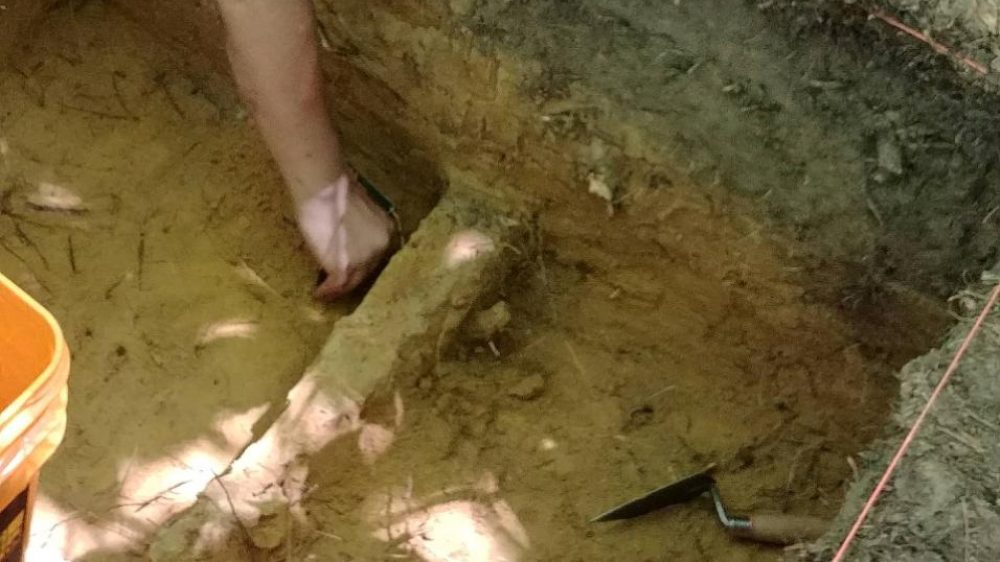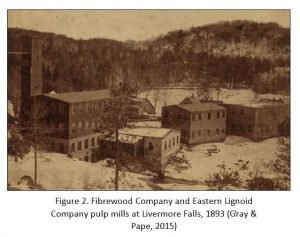Rummaging for History at Livermore Falls
(refer to disclosure statement at end of the post)
Paige Wilson, edited by Mary Ann McGarry – November 15, 2018
Could You Imagine? Probably Not.
Could you imagine living in New Hampshire, pre-European contact? This is considered the Woodland era of Native American history. What would be the first thing you’d wake up and do in the morning - certainly not brew a cup of coffee with your Keurig appliance? Also, our ancestors didn’t wake up and wonder if their friends posted about their breakfast again on Instagram. What did these early inhabitants have to wonder about?
Our ancestors had a very different culture compared to our modern day society. Life was much more about survival and therefore depending on local natural resources. So, as much as we’d all like to live with a Chipotle Restaurant in our backyard, life was different for those who were very connected to their food sources. . Compared to our modern society, where we can order almost anything online and have it delivered in two days using Amazon Prime. The indigenous inhabitants in what was the region of New Hampshire were hunter-gathers, fishers, trappers, and hunters. They had to find their own food, make their clothing and structures. They had no choice but to live a subsistence lifestyle – existing primarily on what could be gathered from their immediate surroundings. Our role now, as a community, is to preserve evidence of their culture, found at Livermore Falls on the banks of the Pemigewasset River just upstream from Plymouth, found underneath later cultures who settled near the mills which provided energy to produce products. The layers of archaeology at the site, thanks to the
State Conservation and Rescue Archaeology Program (SCRAP), are uncovering part of our heritage which we want to understand, preserve, and respect. .
The Depth of History
Six Native Americans sites within the lowlands near Livermore Falls have been identified. At Livermore Falls there is a geologic fault where the river cascades down through tilted metaphorphic rocks into a big eddy pool below. There is a one of a kind bridge spanning the gorge, the remains of a brick mill and stone foundations, walls, and cellar holes of earlier communities, and other historical records documenting the first fish hatchery in the state. In the last couple of years, 2016-2018, artifacts of these various cultures and earlier ones are surfacing thanks to archaeological digs commissioned as the state develops the scenic swimming hole into a state park and popular destination for the bordering towns of Plymouth, Holderness and Campton, NH (New England Waterfalls, 2016).
Three of the discovered sites contain cultural features from what is called the Archaic period (3000-1000 B.C.), and two more contain artifacts from the more recent Woodland period, (1000 B.C. to 900 A.D), (Gray & Pape, 2015).
The river not only provided drinking water, but good fishing for the Native Americans, whose camp sites would have been most active during salmon spawning. The early inhabitants recognized the need to move with their food sources and therefore had minimal belongings they could transport efficiently. Out of all the interesting ecological, hydrological, topographical and geological characteristics where the river narrows at this location, those who followed, the early Euro-American settlers were most drawn to the waterpower of the falls
Around the late-1600’s, European arrivals developed more permanent settlements throughout New Hampshire, including at Livermore Falls. During this colonization period, the falls provided a power source for processing of grain and wool. The early mills later gave way to more industrial pursuits like pulp milling that served markets outside the local area, as shown in Figures 1 and 2 (Gray & Pape, 2015). The milling activity spawned the development of a community that came to be known as the “Hollow,” on the East bank of the river, downstream from the falls. The Hollow was comprised of numerous mills, a tannery, cobbler, blacksmith and New Hampshire’s first fish hatchery. However, the number of people residing at the site at any one time remains uncertain. As much bounty as the river and falls provided, flooding occasionally wiped out human infrastructure in its path, but the settlers persisted and rebuilt until the State of New Hampshire acquired the property.
What’s Been Left Behind?
State archaeologists, David Trubey and Edna Feighner, have facilitated archaeologic digs around Livermore Falls during the summers 2016-2018, where their teams have uncovered Native American pottery (Figure 3), tool making debris, post-contact period glass, nails, buttons and clay pipes. As much fun as it is to collect historical artifacts, archaeologists are just as interested in understanding the people who made and owned the objects. Part of the archaeologic process involves decoding the events that occurred in the past. Both pre-European and the more recent post-European contact sites were buried by sediment from the dynamic river that still floods. So, archaeologists had to systematically dig sample pits through the layers of deposited sediment. If they found something, then they knew where to concentrate their efforts to find more to begin the process of unraveling the chronology of the layered communities.
Today, a number of cellar holes from the Hollow period are exposed on site. Some of these rock foundations are remnants of past homes. Fieldwork revealed nine foundations on both sides of the Pemigewasset River, most are located within the Hollow found on the south-east side of the river. Records have revealed the area was an active industrial and residential site for nearly two hundred years. One after another, generations of mills operated and were eventually demolished due to fires and floods. Until archaeologists were hired to excavate the area to install recreational toilet facilities for the new park being developed, there wasn’t much above ground evidence left of the long history of settlements. After the archaeologists discovered evidence of earlier development on the site, they determined the need to create a history profile of Livermore. Additional support came from the Federal Emergency Management Agency (FEMA), who held an interest in providing funding for flood zone studies and was able to endorse the excavation during the summer of 2017.
A Student's Contribution
Visiting David and Edna in their archaeology lab in Concord, NH was like stepping back through time. Both were interested to talk about their discoveries and were clearly passionate about their jobs. Holding the artifacts felt like holding a baby – I didn’t want to pick them up too fast or accidentally drop and break them. The object shown in Figure 4 is an unknown tool used around the Hollow time period. From assessing the thin, hollow tool, we made a prediction that it might have been used for collecting medicine samples. One of the more interesting pieces, in my opinion, was a penny from 1860 engraved with Queen Elizabeth’s profile (Figure 5). More photos from the lab visit can be found at the end of this blog post.
Archaeology is a repetitive and rewarding process that requires patience.. Much time is spent scraping away the surface of the earth, screening the soil layer by layer, looking for samples, recording site details and assessing the artifacts.Excavation techniques are site-dependent and shovel test pits (50 cm x 50 cm) are dug along transects spaced 8 meters apart at Livermore Falls. Artifacts are mostly scattered within the A and B soil horizons most near the surface which show flooding and other land disturbances. A good indicator of a pre-contact site is a hearth comprised of fire-altered rocks and charcoal. For a post-contact site, a buried wall and stains in the soil from rotted wooden posts are strong indicators to keep digging!
One goal of archaeology is to preserve, conserve and engender respect for cultural history. Imagine a future archaeologist, in the year 2600, digging up the area around Livermore Falls – what would he or she find? From the college students who visited, maybe a bunch of Juul pods and some Bud Light cans. If community members can recognize the connection between their current activities and what future historians will uncover, maybe they’ll think twice about what they leave behind. One can say learning the history of our communities in New Hampshire through archaeological digs and from other historical documents is integral to understanding ourselves.
Want to Dig Deeper into Livermore?
Join David and Edna on one of their upcoming archaeologic digs in Summer 2019! The two scientists will be leading a State Conservation and Rescue Archaeology Program (SCRAP) dig of the industrial area of Livermore Falls. Residents are welcomed to volunteer and students can participate for college credits. For more information and registration details, click on the SCRAP Filed in Historical Archaeology link in the references.
Disclosure note:
As a responsible member of society, it is important to keep in mind that archaeological sites, including those found at Livermore State Forest, are nonrenewable resources. We have to be aware that these sites hold information from pre and post contact life can easily be lost forever. As these sites are also a part of a NH State Forest, it is ILLEGAL to remove artifacts, dig or metal detect. This is a place where good stewardship is necessary to preserve the landscape’s historical and natural features for future generations.
References:
Biello, Peter, Digging Up Evidence of New Hampshire’s Earliest Inhabitants. June 12, 2017. Retrieved November 1, 2018 from http://www.nhpr.org/post/digging-evidence-new-hampshires-earliest-inhabitants#stream/0.
David Trubey, Archaeologist, Review and Compliance Coordinator. NH Division of Historical Resources. Personal interaction.
Edna Feighner, Archaeologist. NH Division of Historical Resources.
Gray & Pape, Inc., Cultural Landscape Report and Environmental Assessment Livermore Falls, Grafton County, New Hampshire. December 22, 2015. Retrieved October 17, 2018.
Livermore Falls, New England Waterfalls. 2016. Retrieved November 13, 2018. http://www.newenglandwaterfalls.com/nh-livermorefalls.html
SCRAP Field in Historical Archaeology. The “Hollow” Livermore Falls, NH July 9-August 3, 2018. Retrieved November 13, 2018. https://www.nh.gov/nhdhr/scrap_info.htm



